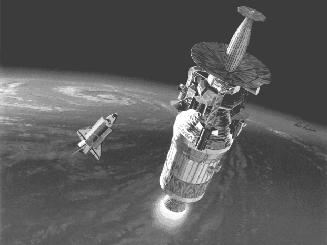

 On October 12, data returned from the Jupiter-bound spacecraft Galileo
indicated problems with an on-board tape recorder which had apparently failed
to stop rewinding after collecting imaging data. The tape recorder was
commanded into a standby mode so the problem could be investigated. At the
onset of the problem, it was feared that much of the spacecraft's mission would
be lost without the tape recorder. Further investigation into the problem
revealed that at least half the mission's original scientific objectives could
be reached without the tape recorder if necessary. This 50% return included the
return of all of the much coveted atmospheric probe data. Galileo Project
Manager William J. O'Neil at JPL said that the problem could have stemmed from
any number of possible mechanical or electrical failures. An identical tape
recorder was being used in the laboratory to help determine the cause of the
malfunction.
On October 12, data returned from the Jupiter-bound spacecraft Galileo
indicated problems with an on-board tape recorder which had apparently failed
to stop rewinding after collecting imaging data. The tape recorder was
commanded into a standby mode so the problem could be investigated. At the
onset of the problem, it was feared that much of the spacecraft's mission would
be lost without the tape recorder. Further investigation into the problem
revealed that at least half the mission's original scientific objectives could
be reached without the tape recorder if necessary. This 50% return included the
return of all of the much coveted atmospheric probe data. Galileo Project
Manager William J. O'Neil at JPL said that the problem could have stemmed from
any number of possible mechanical or electrical failures. An identical tape
recorder was being used in the laboratory to help determine the cause of the
malfunction.With the loss of high-gain antenna early in the mission, all communication had to be conducted at much lower data rates through the low-gain antenna. Engineers scurried to develop a system for getting the most out of the crippled spacecraft and made use of Galileo's tape recorder to "queue" data for return transmission to Earth. Loss of the tape recorder would have reduced the already limited data return of the mission.
On October 20, the tape recorder successfully responded to a test command for the recorder to move and read the tape normally. Now the investigation team is focusing on the development of a conditioning plan and new constraints for use of the tape recorder to maximize its reliability for future operations. According to Project Manager O'Neil, "substantial efforts must now be taken to protect against future difficulties."
 |
 |